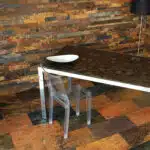Shower tiling is a complex and intricate process that requires precision, attention to detail, and expertise. As professional tile installers, we understand the importance of a well-tiled shower in ensuring both functionality and aesthetics. A properly tiled shower not only adds value to your home but also enhances your daily experience by providing a relaxing and luxurious environment.
In this article, we will guide you through the step-by-step process of how to tile a shower. From selecting the appropriate tiles to preparing the surface area and laying the tiles, we will cover every aspect of the tiling process. We will also provide tips and tricks for achieving a flawless finish, avoiding common mistakes, and ensuring durability. Whether you are an experienced DIYer or new to tiling, this article aims to equip you with the necessary knowledge and skills for successfully tiling your shower.
Assessing Your Shower Space
When it comes to tiling a shower, the first step is to assess the shower space. Start by measuring the size of your shower. This will help you determine how much tile you need and what layout options are available. The most common shower sizes are 32 inches by 32 inches, 36 inches by 36 inches, and 48 inches by 48 inches.
Once you know the size of your shower, consider the layout options that are available. The most popular layout is a straight lay, where tiles are laid in rows from top to bottom or side to side. Another option is a diagonal lay, where tiles are laid at a diagonal angle. A third option is a herringbone pattern, which creates a zigzag effect with tiles.
When choosing a layout option, consider the size and shape of your shower as well as your personal preference. Keep in mind that some layouts may require more cuts or be more difficult to install than others. By assessing your shower space and considering layout options, you can ensure that your tiling project goes smoothly and results in a beautiful finished product. As we move onto measuring and calculating tile requirements, it’s important to keep these factors in mind for accurate calculations.
Measuring And Calculating Tile Requirements
Assessing your shower space is an important step in ensuring a successful tiling project. Once you have measured your shower space, it’s time to consider your tile pattern options. Tile patterns can range from traditional to modern, and the choice you make can greatly impact the overall look and feel of your shower.
When selecting a tile pattern, it’s important to keep budget considerations in mind. Some patterns may require more tiles or more intricate cuts, which can add to the cost of the project. However, there are also many affordable options available that still provide a beautiful finish. As a professional tile installer, my recommendation is to choose a pattern that fits within your budget while still achieving the desired aesthetic for your shower.
In addition to considering tile patterns and budget, it’s also important to select the right tiles for your shower. This requires careful consideration of factors such as durability, slip resistance, and water absorption rates. It’s crucial to choose tiles that are specifically designed for use in wet areas like showers in order to avoid any potential safety hazards or damage down the line. As you move forward with tiling your shower, keep these factors in mind in order to ensure a successful and long-lasting result.
Selecting The Right Tiles For Your Shower
When selecting tiles for your shower, it is important to consider both the functionality and aesthetics of the tile. Popular tile finishes include ceramic, porcelain, natural stone, and glass. Ceramic and porcelain are budget-friendly options that are durable and easy to clean. Natural stone provides a unique look but requires more maintenance to prevent staining and chipping. Glass tiles offer a modern look but can be slippery when wet.
In addition to the type of tile material, you should also consider the size and shape of the tiles. Larger tiles can make a small shower appear larger, while smaller tiles can create intricate designs. The shape of the tile can also add visual interest to your shower. Rectangular tiles can create a classic look while hexagonal or mosaic-shaped tiles offer a more contemporary feel.
Budget-friendly tile options include ceramic and porcelain as well as subway or penny round tiles. These options provide a stylish look without breaking the bank. If you have a larger budget, natural stone or glass tiles may be worth considering for their unique appearance.
Now that you have selected the right tiles for your shower, it’s time to prepare the surface area for tiling. This step is crucial in ensuring that your shower remains waterproof and free from damage caused by moisture over time.
Preparing The Surface Area For Tiling
Surface preparation is a critical step in tiling a shower, as it ensures that the tiles will adhere properly and withstand moisture over time. Before installing tiles, it is important to remove any existing materials such as paint, wallpaper, or old tiles. The surface should be clean and free of any dirt or debris that could interfere with the bonding process.
In addition to cleaning the surface area, there are several other techniques that can be used to prepare it for tiling. One of the most important steps is to ensure that the surface is completely flat and level. This can be achieved by using a self-leveling compound, which fills in any low spots and creates an even base for the tiles.
Another crucial aspect of surface preparation is waterproofing. Since showers are constantly exposed to water, it is essential to take measures to prevent moisture from seeping through the walls and causing damage. There are several methods for waterproofing a shower, including applying a liquid membrane or using backer board with built-in waterproofing properties.
The next step in tiling a shower is applying waterproofing membrane or backer board. By following these surface preparation techniques, you can ensure that your shower will withstand moisture over time and provide long-lasting beauty and function.
Applying Waterproofing Membrane Or Backer Board
To ensure that your shower tiling project is successful, it is essential to apply waterproofing techniques such as a waterproofing membrane or backer board installation. Without proper waterproofing, your shower may develop mold and mildew, which can lead to structural damage over time. Let’s take a hypothetical situation where a homeowner decided to skip the waterproofing step and ended up with water seeping through the grout lines into their bathroom floor, causing significant damage.
If you want to avoid this kind of scenario, follow these four steps for applying waterproofing membrane or backer board installation:
- First, make sure that the surface you will be applying the membrane or backer board to is clean and free from any debris.
- Next, apply the chosen waterproofing material in accordance with the manufacturer’s instructions. This may include using a trowel, roller, or spray-on application method.
- Be sure to let the material dry completely before proceeding with any further steps.
- Once dry, inspect the surface for any cracks or gaps that may have formed during the drying process and fill them appropriately.
By following these steps, you’ll create a waterproof barrier that will protect your shower from water damage for years to come. Now that you’ve taken care of this crucial step, it’s time to move on to creating your tile layout plan.
Creating A Tile Layout Plan
After applying waterproofing membrane or backer board, the next step in tiling a shower is to create a tile layout plan. This involves measuring the area to be tiled and determining the size and pattern of tiles that will be used. Planning tools such as graph paper, a straight edge, and a tape measure can help with this process.
When creating a tile layout plan for a shower, there are several design considerations to keep in mind. One important factor is the size of the tiles. Larger tiles can make a small shower feel more spacious, while smaller tiles can create visual interest and texture. Another consideration is the color and pattern of the tiles, which can affect the overall look and feel of the space.
Once the tile layout plan has been finalized, it’s time to start cutting tiles to size. This involves using a tile cutter or wet saw to cut individual pieces of tile to fit into any gaps or corners in the shower area. It’s important to take accurate measurements and use proper safety precautions when cutting tiles, as mistakes can be costly and dangerous. With careful planning and attention to detail, however, tiling a shower can be a rewarding DIY project that adds value and beauty to any home.
Cutting Tiles To Size
Before cutting tiles to size, it is important to note that each tile cutting technique requires different tools for cutting tiles. The most common methods of cutting tiles involve the use of a manual tile cutter, wet saw, or angle grinder. Manual tile cutters are ideal for straight cuts and are often used for ceramic tile installations. Wet saws, on the other hand, are perfect for larger projects and can cut through thicker materials such as stone or porcelain tiles. Angle grinders are best for making irregular cuts or cuts in small spaces.
To begin the process of cutting tiles to size, it is essential to gather all necessary tools and equipment before starting the project. This should include a tile cutter, measuring tape, pencil, safety goggles, and gloves. Once all tools have been collected and organized, measure the space where the tile needs to be installed and mark it with a pencil.
Using a tile cutter, score along the marked line and snap off any excess material carefully. When using more advanced tools such as wet saws or angle grinders, it is important to take extra precautions by wearing protective gear such as gloves and goggles. Follow manufacturer instructions carefully when using these tools to ensure proper usage and avoid potential injuries. With these techniques in mind and appropriate tools on hand, anyone can successfully cut tiles to size with ease.
Transition: Now that we have covered how to cut tiles correctly let us move on to the next step: mixing and applying tile adhesive…
Mixing And Applying Tile Adhesive
Before installing tiles in a shower, it is crucial to understand the mixing techniques of tile adhesive. Different types of adhesives have different requirements for mixing, so it is essential to read the manufacturer’s instructions. Usually, powdered tile adhesive requires mixing with water to form a paste-like consistency. It is crucial to mix the adhesive thoroughly until there are no dry lumps or clumps left.
There are several types of tile adhesive available in the market, such as mastic and thin-set mortar. Mastic adhesive is suitable for small-sized tiles and low-moisture areas such as backsplashes and walls. On the other hand, thin-set mortar is perfect for large-sized tiles, high-moisture areas like showers, and outdoor spaces. It is essential to choose an appropriate adhesive type that matches the tile material and area where you want to install them.
Now that you have understood the basics of tile adhesive mixing technique and types let’s move on to applying it on your shower wall. Start by spreading a layer of adhesive onto a small section of the wall using a notched trowel. Make sure to apply enough pressure to ensure that the adhesive sticks firmly onto the surface. Then place each tile onto the wall one by one while pressing them gently into place. Remember not to spread too much adhesive at once as it may dry out before you can lay all your tiles.
With your knowledge of mixing techniques and types of adhesives in mind, you are now ready to begin applying your chosen product onto your shower walls. The next step will be laying the first row of tiles on top of this freshly applied layer of glue with precision and care for best results.
Laying The First Row Of Tiles
- Accurately measuring the wall is the first step in laying the first row of tiles.
- The starting point should be marked with a pencil or a chalk line to ensure a straight line of tiles.
- To ensure a good fit, tile cuts may be necessary along the edges of the wall and cuts should be made with a wet saw.
- Special attention should be given to the positioning of the tiles to create an aesthetically pleasing design.
Measuring The Wall
Accurately measuring the wall is crucial for laying the first row of tiles in a shower. It is essential to use proper measuring tools to ensure that the tiles are cut and placed correctly. As a professional tile installer, I would recommend using a laser level to mark out the measurements on the wall. This tool ensures that everything is level and plumb, preventing any issues with drainage or water pooling.
One of the common mistakes that people make when measuring a shower wall is not taking into account any obstacles such as plumbing fixtures or windows. These obstacles can affect the placement of tiles and may require additional cuts to be made. Another mistake is not allowing for grout lines between each tile, which can result in having too many or too few tiles for the space.
To avoid these common mistakes, it is important to take detailed measurements of the entire shower area before cutting any tiles. This will enable you to plan out where each tile will go and what size will be needed. By taking your time with this step, you will save yourself from costly errors later on in the tiling process. Remember, accuracy in measuring is key to achieving a beautiful and functional tiled shower area.
Marking The Starting Point
Determining the placement of the first row of tiles is a critical step in tiling a shower. As a professional tile installer, I highly recommend marking the starting point before laying any tiles. This will not only ensure that the tiles are placed accurately but also prevent mistakes that could affect the overall look and functionality of the tiled shower area.
One common mistake when marking the starting point is not accounting for any obstructions such as plumbing fixtures or windows. These obstacles can impact where the first row of tiles should be placed, and failing to consider them may result in having to redo your work. Another mistake is not leaving enough space for grout lines between each tile. This can cause tiles to overlap or leave large gaps, which can make your shower look unprofessional.
To avoid these mistakes, take your time when marking the starting point for your shower tiles. Use a level to ensure that everything is straight and plumb. Additionally, remember to account for any obstacles on the wall and allow space for grout lines between each tile. By taking these steps, you will ensure that your first row of tiles is correctly placed, and you will have a beautiful and functional tiled shower area that will last for years to come.
Installing Bullnose Or Border Tiles
When it comes to tiling a shower, installing bullnose or border tiles is an important step in creating a finished look. These types of tiles are typically used to create a smooth and polished edge around the perimeter of the shower or to add an accent to the main field of tiles. One popular technique for using these tiles is by using contrasting colors to create unique patterns that enhance the overall aesthetic appeal of the shower.
Using contrasting colors is an effective way to add visual interest and depth to your shower design. For example, you could use a dark-colored bullnose tile with lighter colored field tiles or vice versa. Alternatively, you could also use different textures or finishes for your bullnose or border tiles to create a subtle contrast that adds dimensionality and texture to your shower design.
Another way to create unique patterns using bullnose or border tiles is by alternating their placement with standard field tiles. You could place them every few rows or use them as a border along the top or bottom of the shower wall. This technique can help break up large expanses of plain tile and add interest and variety without being too overwhelming or distracting from the overall design.
By incorporating contrasting colors and unique patterns into your tile installation, you can elevate the look of your shower while maintaining its functionality. The next step in this process involves grouting the tiles, which will be discussed in more detail in the subsequent section.
Grouting The Tiles
Once the tiles have been properly laid out and set, it is time to grout them. Grouting is an essential step in tile installation as it fills in the gaps between the tiles and creates a uniform surface that protects against water infiltration. There are various color options available for grout, so choose one that complements your tile selection.
Before applying the grout, ensure that the tile surface is clean and free of any debris or excess adhesive. Begin by mixing the grout according to manufacturer instructions and apply it to the joints using a rubber float. Work in small sections and use a diagonal motion to ensure complete coverage. Once applied, use a damp sponge to remove any excess grout from tile surfaces.
After applying grout, it is important to keep the tile surfaces clean to prevent discoloration or staining over time. Avoid using harsh chemicals on newly installed grout as this can cause damage or discoloration. Instead, opt for gentle cleaning techniques such as warm water and mild soap solution or specialized grout cleaners specifically designed for your chosen color option.
Moving forward from here, sealing the grout is an important step in ensuring its longevity and durability. This will help protect against moisture penetrating through porous areas of the grout while also making future cleaning much easier. With proper care and maintenance, your tiled shower will remain beautiful and functional for years to come.
Sealing The Grout
Now that the tiles have been securely placed and the grout has been applied, it’s time to consider the finishing touches. One important factor to consider is choosing the right grout color to complement your tiles. The color of the grout can impact the overall look of your shower, so take some time to carefully choose a shade that will enhance the beauty of your tiles.
After you’ve chosen your grout color and allowed it to dry completely, it’s essential to apply a grout sealant. This step is crucial in protecting your newly installed shower from moisture damage and staining. A high-quality grout sealant will help prevent water from penetrating into the grout and causing mold or mildew growth, which can be harmful to both your shower and health.
Properly sealing your grout can also make cleaning much easier in the long run. Once you’ve finished sealing the grout, it’s recommended that you regularly clean and maintain your tiled shower with gentle cleaners specifically designed for tile surfaces. By taking these necessary steps, you’ll ensure that your new tiled shower remains beautiful and functional for years to come.
Cleaning And Maintaining Your Tiled Shower
Shower tile maintenance is essential to keep your tiled shower looking new and clean for a long time. Regular cleaning is crucial to prevent dirt buildup, soap scum, and other stains that can discolor the grout or tile surface. It’s recommended to clean your shower tiles every week to keep them in good condition.
Preventing grout discoloration requires some extra effort. You can apply a sealant over the grout lines after installation or reapplication every six months. This will help protect the grout from moisture and stains, keeping it clean and clear for a long time. Another way is to avoid using harsh chemicals when cleaning your tiles as they can cause discoloration and damage.
Here are some tips on maintaining your tiled shower:
- Use a squeegee or towel to dry off wet areas after each use.
- Avoid using abrasive cleaners or scrubbers on the tile surfaces.
- Clean up spilled toiletries immediately before they stain the tiles.
- Keep your bathroom well-ventilated to prevent mold growth and moisture buildup.
Ensuring proper shower tile maintenance will save you time, money, and effort in the long run by preventing costly repairs or replacements due to neglect or damage caused by improper care. In the next section, we’ll discuss troubleshooting and fixing issues that may arise with your tiled shower installation.
Troubleshooting And Fixing Issues
As the saying goes, “measure twice, cut once.” This adage serves as a reminder to all tile installers that accuracy is key. When tiling a shower, it is essential to avoid common mistakes and take preventative measures to ensure that the finished product meets both aesthetic and functional standards.
One of the most common mistakes in tiling showers is not properly waterproofing the area. The failure to waterproof can lead to leaks, mold growth, and costly repairs. Preventative measures include using a waterproof membrane and sealant around areas prone to water exposure such as corners, seams, and niches.
Another common mistake is improper spacing between tiles. Inadequate spacing can cause tiles to shift or crack over time due to moisture expansion. To prevent this issue, use spacers between each tile during installation. It is also important to consider the type of grout used in between tiles; it should be resistant to mildew and easy-to-clean.
| Common Mistakes | Preventative Measures |
|---|---|
| Improper Waterproofing | Use a waterproof membrane and sealant |
| Inadequate Spacing Between Tiles | Use spacers during installation |
| Unsuitable Grout Type | Select mildew-resistant grout |
As professional tile installers know, tiling a shower requires precision and patience. However, even with proper planning and execution, unforeseen issues may arise that require extra attention. In such cases, it may be necessary to hire a professional tile installer who has the expertise and experience needed to troubleshoot any problems encountered along the way.
Hiring A Professional Tile Installer
Hiring a professional tile installer has several benefits, such as ensuring that the project is completed on time and with high-quality workmanship. A skilled professional can provide expert advice on the best materials and designs to use, based on their experience in the field. Additionally, hiring a professional can save you money in the long run by avoiding costly mistakes that may arise from DIY or inexperienced installations.
The cost effectiveness of hiring a professional tile installer is often underestimated. While it may seem expensive at first, considering the cost of materials and tools needed for an installation, hiring a professional can actually be more economical in the long run. Professionals have access to better quality materials at lower prices due to their relationships with suppliers, and they have all the necessary tools and equipment readily available.
By hiring a professional tile installer, you are investing in your home’s value and longevity. Professional installations offer a higher level of precision and attention to detail that can make all the difference in achieving a stunning result. Additionally, professionals provide warranties for their workmanship, which provides peace of mind knowing that any issues will be addressed promptly and without additional cost to you. In short, hiring a professional tile installer is an investment that pays off both financially and aesthetically.
Conclusion
When it comes to tiling a shower, there are several steps that must be followed in order to achieve a successful outcome. It all starts with assessing your shower space and measuring and calculating the necessary tile requirements. From there, selecting the right tiles for your shower is crucial in achieving the desired aesthetic.
Preparing the surface area for tiling is also important as it ensures that the tiles will adhere properly. This involves applying waterproofing membrane or backer board before sealing the grout. Once your tiled shower is complete, proper cleaning and maintenance will ensure its longevity. However, if issues do arise, troubleshooting and fixing them promptly can prevent further damage.
As a professional tile installer, I strongly recommend taking these steps seriously in order to achieve a beautiful and functional tiled shower. Remember that attention to detail is key when tiling any space, including showers. So take your time and enjoy the process of creating a stunning new feature in your home. As they say, “measure twice, cut once” – making sure everything is done correctly from the start can save time and money in the long run.
Image Credits
- “Shower + floor tiles.” by dalazzarato (featured)





























